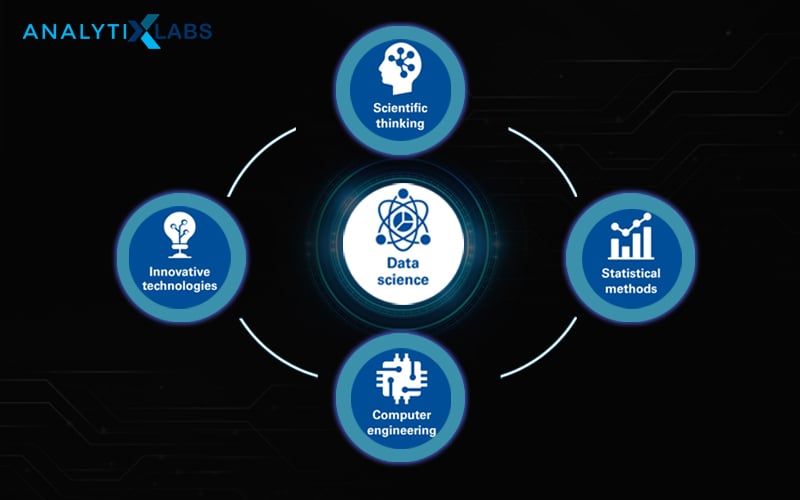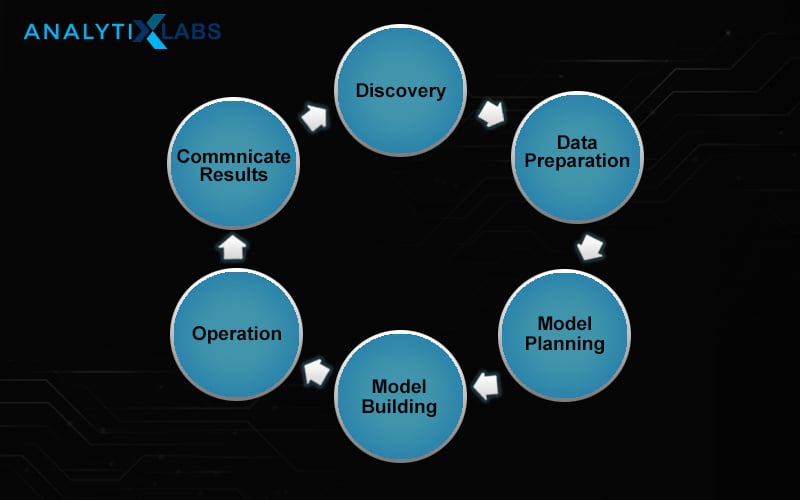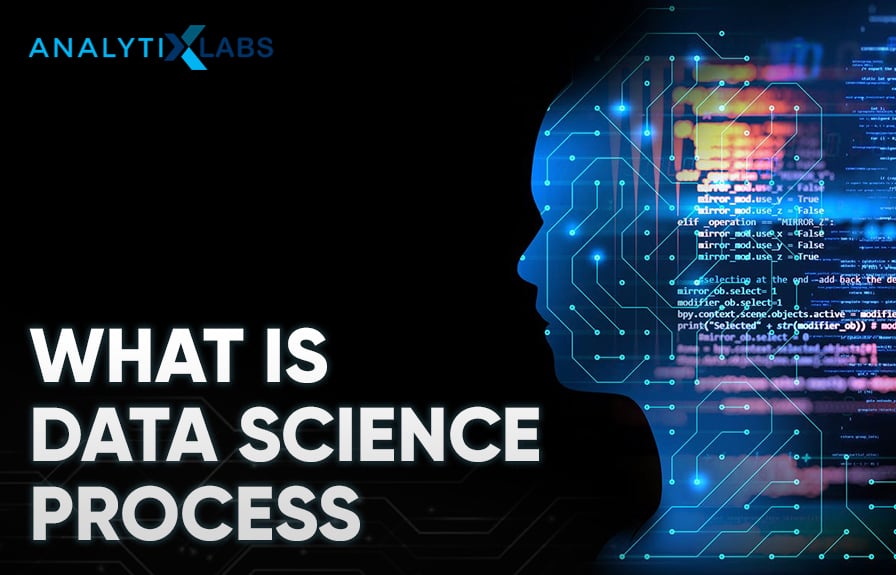Preface
Data Science is the buzzword in the present market. As the market constantly changes in various ways, data science is getting popular among businesses to learn about their customers and increase profitability. Data science even assists technologies like AI (artificial intelligence) and ML (machine learning). As technical tools are evolving, data science techniques are also maturing with them. Everyone cannot be a data genius or a tech whiz, but other professionals will soon need a data science process. This article will talk about data science, explain data science process, and how data scientists go about the whole process so that everyone can get familiar with the process.

Introduction
Data Science is an associated field of Big Data designed to analyze large mounds of complex and raw data and provide meaningful information based on that data to the company. It is a combination of many fields such as statistics, mathematics, and computation to interpret and present data for effective decision-making by business leaders. Data Science helps businesses improve their performance, efficiency, customer satisfaction, and meet financial goals more easily. But, for data scientists to use data science effectively and give beneficial, productive results, a deep understanding of the data science process is required. The different stages of the data science process help in converting data into practical outcomes. It helps in analyzing, extracting, visualizing, storing, and managing data more effectively.
AnalytixLabs helps in providing training in Business Analytics, AI, and Data Science. As a pioneer in data science training, it is among the best institutes where you can pursue courses in data analytics, artificial intelligence, machine learning, and big data.
What is Data Science Process? A Quick Outline
Data Science is all about a systematic process used by Data Scientists to analyze, visualize and model large amounts of data. A data science process helps data scientists use the tools to find unseen patterns, extract data, and convert information to actionable insights that can be meaningful to the company. This aids companies and businesses in making decisions that can help in customer retention and profits. Further, a data science process helps in discovering hidden patterns of structured and unstructured raw data. The process helps in turning a problem into a solution by treating the business problem as a project. So, let us learn what is data science process is in detail and what are the data science process steps.
The six data science process steps are as follows:
- Frame the problem
- Collect the raw data needed for your problem
- Process the data for analysis
- Explore the data
- Perform in-depth analysis
- Communicate results of the analysis
As the data science process stages help in converting raw data into monetary gains and overall profits, any data scientist should be well aware of the process and its significance. Now, let us discuss these data science steps in detail.
Steps in Data Science Process
A data science process can be more accurately understood through data science online courses and certifications on data science. But, here is a step-by-step guide to help you get familiar with the process.

Step 1: Framing the Problem
Before solving a problem, the pragmatic thing to do is to know what exactly the problem is. Data questions must be first translated to actionable business questions. People will more than often give ambiguous inputs on their issues. And, in this first step, you will have to learn to turn those inputs into actionable outputs.
A great way to go through this step is to ask questions like:
- Who the customers are?
- How to identify them?
- What is the sale process right now?
- Why are they interested in your products?
- What products they are interested in?
You will need much more context from numbers for them to become insights. At the end of this step, you must have as much information at hand as possible.
Step 2: Collecting the Raw Data for the Problem
After defining the problem, you will need to collect the requisite data to derive insights and turn the business problem into a probable solution. The process involves thinking through your data and finding ways to collect and get the data you need. It can include scanning your internal databases or purchasing databases from external sources.
Many companies store the sales data they have in customer relationship management (CRM) systems. The CRM data can be easily analyzed by exporting it to more advanced tools using data pipelines.
Step 3: Processing the Data to Analyze
After the first and second data science process steps, when you have all the data you need, you will have to process it before going further and analyzing it. Data can be messy if it has not been appropriately maintained, leading to errors that easily corrupt the analysis. These issues can be values set to null when they should be zero or the exact opposite, missing values, duplicate values, and many more. You will have to go through the data and check it for problems to get more accurate insights.
The most common errors that you can encounter and should look out for are:
- Missing values
- Corrupted values like invalid entries
- Time zone differences
- Date range errors like a recorded sale before the sales even started
You will have to also look at the aggregate of all the rows and columns in the file and see if the values you obtain make sense. If it doesn’t, you will have to remove or replace the data that doesn’t make sense. Once you have completed the data cleaning process, your data will be ready for an exploratory data analysis (EDA).
Related: What Is Data Preprocessing in Machine Learning | Examples and Codes
Step 4: Exploring the Data
In this step, you will have to develop ideas that can help identify hidden patterns and insights. You will have to find more interesting patterns in the data, such as why sales of a particular product or service have gone up or down. You must analyze or notice this kind of data more thoroughly. This is one of the most crucial steps in data science process.
Step 5: Performing In-depth Analysis
This step will test your mathematical, statistical, and technological knowledge. You must use all the data science tools to crunch the data successfully and discover every insight you can. You might have to prepare a predictive model that can compare your average customer with those who are underperforming. You might find several reasons in your analysis, like age or social media activity, as crucial factors in predicting the consumers of a service or product.
You might find several aspects that affect the customer, like some people may prefer being reached over the phone rather than social media. These findings can prove helpful as most of the marketing done nowadays is on social media and only aimed at the youth. How the product is marketed hugely affects sales, and you will have to target demographics that are not a lost cause after all. Once you are all done with this step, you can combine the quantitative and qualitative data that you have and move them into action.
Step 6: Communicating Results of this Analysis
After all these data science steps, it is vital to convey your insights and findings to the sales head and make them understand their importance. It will help if you communicate appropriately to solve the problem you have been given. Proper communication will lead to action. In contrast, improper contact may lead to inaction.
You need to link the data you have collected and your insights with the sales head’s knowledge so that they can understand it better. You can start by explaining why a product was underperforming and why specific demographics were not interested in the sales pitch. After presenting the problem, you can move on to the solution to that problem. You will have to make a strong narrative with clarity and strong objectives.
You may also like to read: Difference Between Data Analysis and Interpretation – An Overview
To understand the filed of Data Science even more, you can learn from our premium data science learning materials and our exclusive PG Data Science certification course course at your convenience, or you can book a demo with us.
Significance of Data Science Process
Following a data science process has various benefits for any organization. Also, it has become extremely important for achieving success in any business. Here are the reasons that should give you a nudge to include a data science process in your data collection routine:
1. Yields better result and increases productivity
Any company or business with data or access to data is undoubtedly at an advantage over other companies. Data can be processed in various forms to obtain the information required by the company and help it make good decisions. Using a data science process makes decisions and gives business leaders confidence in those decisions because stats and details back them. This gives a competitive advantage to the company and increases productivity.
2. Report making is simplified
In almost all cases, data is used to collect values and make reports according to those values. Once the data is appropriately processed and placed into the framework, it can be easily accessed without any hassle with a click and makes preparing reports a matter of just minutes.
3. Speedy, accurate, and more reliable
It is extremely important to ensure that data collection, facts, and figures are done at a speedy pace and without any error. A data science process is applied to data gives little to negligible chance of errors or mistakes. This makes sure the process that comes after can be performed with more accuracy. And the process provides better results. It is not uncommon that several competitors have the same data. In this case, the company with the most accurate and reliable data has an advantage.
4. Easy Storage and Distribution
When piles of data are being stored, the place needed to store it must also be humongous. This gives rise to chances of missing or confusing information or data. A data science process gives you extra room to store papers and complex files and label the complete data through a computerized setup. This decreases confusion and makes data easy to access and use. Having the data stored in a digital form is another advantage of the data science process.
5. Cost reduction
Collecting and storing data using a data science process eliminates the need to gather and analyze data over and over again. It also makes it convenient to make copies of the stored data in digital form. Sending or transferring data for research purposes becomes easy. This reduces the overall cost to the company. It also encourages cost reduction by protecting the data which may otherwise be lost in papers. Loss due to lack of certain data is also reduced by following a data science process. Data helps make devised and confident decisions which further leads to reduced costs.
6. Safe and secure
Having data stored through a data science process digitally makes information much more secure. The value of data increases with time, which has made data theft more common than before. Once the processing of data is done, the data is secured by various software, which prevents any unauthorized access and encrypts your data simultaneously.

You may also like to read: What is the Data Science Life Cycle? | Everything you need to know
FAQs- Frequently Asked Questions
Q1. What problems do Data Scientists solve?
Customer satisfaction, Credit risk management, Climate change, air pollution, poverty, and many other extreme problems can be solved by data scientists in the long term with their expertise. They solve the problems of companies and businesses by giving transformative services and products in every sector of today’s industry.
You may also like to read: Data Scientist Job Description | Role of Data Scientist
Q2. Which step in the data science process is the most important?
All the steps in data science process are equally important and should be performed with utmost care and rigor without any lapses to get the best results. Processing the data for analysis should be done with utmost sincerity and attention to detail, as it highly affects the outcome of the process.
A famous saying in Analytics realms about the importance of data processing in data science is “Garbage in Garbage out.”
Q3. What are the three methods of data processing?
The three main methods of data processing in data science are:
- Batch data processing
- Online data processing
- Real-time data processing
Conclusion
A data science process is not linear and will vary depending on the stage you are currently at. This will make your day-to-day routine vary significantly and often you will have to do tasks that fall behind your area. You will have to go back and forth through steps before you finally reach the end of the process. It is important to properly understand a data science process and the steps involved to think systematically. Your career in data science will boost and expand exponentially once you understand a data science process better.
You may also like to read:
1. Top 25 Data Science Books – Learn Data Science
2. Data Science Vs. Business Analytics; Do You Know the Difference?
3. Is Data Science Hard Or Easy? How to Start a Career in Data Science








